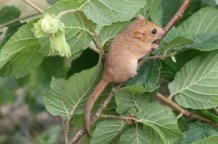
The research highlights that hazel dormice shoud be classified as "endangered", not "vulnerable".
New research has highlighted issues about how the conservation status of different species is classified, and suggests the focus should be on restoring species now rather than waiting for them to become threatened with extinction before acting.
The research from the University of Exeter also highlights that Britain's native hazel dormice are in chronic decline, need urgent conservation action, and should in fact be classified as "endangered", not "vulnerable".
Conservation status is important – it determines how much attention, funding and urgency is given to protecting a particular animal or plant.
Strict international criteria currently guide how conservationists classify how threatened a species is, but the new report shows that the chronic decline in hazel dormouse numbers doesn't fit with their current classification status, due to the current guidelines for classification.
PhD student Ellie Scopes, of the Environment and Sustainability Institute on Exeter's Penryn Campus in Cornwall, and colleagues have also found that a species can experience a dramatic decline without being classified as endangered – meaning hazel dormice are more of a conservation concern than is currently perceived.
The report has been published today in Ecological Solutions and Evidence.
Using data from the National Dormouse Monitoring Programme (NDMP), which is managed by wildlife charity People's Trust for Endangered Species (PTES), Scopes and colleagues found that the information used to best measure the risk of extinction is dependent on shifting baselines.
"The IUCN Red List is the leading tool used in wildlife conservation to measure how likely a species is to go extinct and assesses the level of urgency needed to prevent that from happening," Scopes said.
"To become classified as 'endangered' a species has to decline at a rate of over 50% within a 10-year period.
"If the population is small or has a smaller range it's easier to measure the decline using those parameters, but if a species is widespread and declining over a longer period of time it won't be classified in the same way.
"This concept is very useful for identifying steep, short declines, but misses more gradual, chronic losses.
"Hazel dormice were classified in 2020 as 'vulnerable' on the Red List for Britain's Mammals.
"The Red List assessment was made by analysing the NDMP data up to 2014, which indicated that populations were very close to being listed as Endangered because the rate of decline was so steep.
"My colleagues and I used two different methods to assess NDMP data up to 2020 to find out whether any further decline has happened and therefore if their conservation status has changed."
Monitoring dormice numbers via PTES' NDMP involves licensed volunteers checking dormouse nest boxes throughout the active season to see if dormice are present.
The programme began in 1988 and now over 400 NDMP sites are monitored across the country.
The data gathered shows population change over a considerably longer period than the 10 years used for Red List assessment.
This enabled Scopes to compare trends over 10-year and longer periods, examining how well the assessment of extinction risk encompasses change in populations and in conservation status.
Previous analyses of the NDMP data showed a population decline of 72% between 1993 and 2014.
The 2020 Red List for British Mammals based their classification in part on this, on the basis that dormice had declined by more than 30%, but less than 50% over the most recently quantified 10-year period.
Scopes and colleagues looked at more recent data (1994-2020) and compared the overall decline during that 27-year period with incremental 10-year windows – mirroring the period over which the IUCN assesses change.
The overall decline during the 27-year period was a staggering 78%, and yet because this didn't take place during a single decade, the classification of dormice doesn't change.
More worryingly, the rate of decline over each 10-year period has accelerated recently, but hovers around the 50% figure meaning that hazel dormice are still considered "vulnerable" but not "endangered".
Nida Al-Fulaij, Conservation Research Manager at PTES, said: "Ellie's work has highlighted how the scale and presentation of a species' decline can affect its perception, and as things stand dormice are not considered as threatened as other species despite their decline in numbers being very similar, if not worse.
"It's also important to note that measures of change over otherwise somewhat arbitrary 10-year periods underplay the importance of declines in species that have short generation lengths but low productivity, which can't recover as quickly.
"Hazel dormice have smaller and fewer litters, and have a much shorter active period compared with other small mammals which can have multiple litters across the whole year.
"As a result, they'll naturally be less able to recover from severe declines and therefore should be considered an even higher priority in terms of conservation action."
Scopes' PhD is supported by Natural Environment Research Council, via the GW4+ Doctoral Training Partnership, and the University of Exeter with CASE partners at Forest Research and Natural England.
PTES works tirelessly to understand the pressures facing hazel dormice and how to combat their ongoing decline.
Woodland management training, annual reintroductions and running the NDMP all play a crucial part in the attempt to save hazel dormice, but more funding, time and research is needed.






